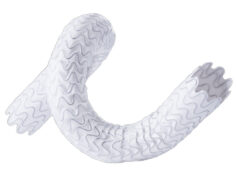
Scott Trerotola (University of Pennsylvania, Philadelphia, USA), who is set to be awarded a Society of Interventional Radiology (SIR) Gold Medal in June 2022, sits down with Renal Interventions to share his views on the 2019 update to the Kidney Disease Outcomes Quality Initiative (KDOQI) vascular access guidelines.
Interventionists need to read the guidelines. Whilst there will soon be several different tools out there that will be easy to digest, such as a YouTube video or a podcast, there is no substitute for reading the guidelines. They are the result of a 25-year process of refinement, iteration, research and opinion, so they are the best thing we have got right now.
I love the way that the most recent KDOQI update looks at access as a ‘life plan’—because you cannot take a 99-year-old patient and compare them to a 25-year-old patient who is going to be on dialysis for many years until they eventually, hopefully, get a transplant. And, if you are practising dialysis access interventions, it behoves you and your patient to read those guidelines. Not doing so really means that you are not practising evidence-based medicine—and you should be.
Good medicine struck down by lack of evidence
Guidelines by their very nature become a research workbook for the next generation. There is a fundamental problem associated with any guideline formation. The fact of the matter is that committees are a victim of the evidence team, which changes, and looks at the exact same evidence with a different eye. A lot of evidence had changed by the time the KDOQI guidelines were updated in 2019, and it appears that the evidence team tried to really push as hard as they could, even when there was not all that much evidence. In doing so, they backed off on a lot of existing beneficial guidelines. I am not sure that was the right thing to do. One of the most significant examples of this is in the vessel of choice for dialysis catheters and the order in which they should be used.
Previously, the guidelines essentially said internal jugular first, then external jugular, and we can all agree on that. But, the subclavian vein was listed as being the absolute last choice and it was made clear that it should not be used except in extreme situations. In the latest update, it was actually moved to the third position, on the basis that there was no high-level evidence precluding this—which is insanity, as there will never be a randomised controlled trial of subclavian versus other tunnelled dialysis catheter sites. It just makes no sense whatsoever and opens the doors for a variety of complications that we literally have not seen (and for good reason) in 30 years. So, if we now allow interventionists to start putting catheters in the subclavian, the harm that is going to come to this patient population is really significant.
“One of the areas that the KDOQI guidelines did not go strongly enough on was promoting and preserving the concept of over-the-wire exchange for infection.”
Another important element is that they raised transfemoral above translumbar access to the inferior vena cava. Both of these access types have been studied independently and the infection rate is three times higher for transfemoral; it takes a viable access site and/or potential transplant site and, at least a quarter of the time, destroys it by virtue of venous thrombosis. It is also much more of an issue when somebody develops catheter-related venous thrombosis in a femoral vein. All this just does not happen with translumbar access. Of course, not everyone is suitable for translumbar, but—for those who are—it is a much better access route. Now, is this supported by randomised data? No, and it never will be. However, it is supported by level two evidence that the KDOQI evidence team just seems to have ignored. They essentially appear to have refused to consider lower-level evidence. What we (prior KDOQI teams) did in the past, repeatedly, was to then apply expert opinion, especially when we saw something we felt was good medicine being struck down by lack of evidence. Charmaine Lok (University of Toronto, Toronto, Canada) and team did that elsewhere, such as in dialysis access surveillance—I just wish they had done it in a few more places, but that is my opinion.
One of the areas that the KDOQI guidelines did not go strongly enough on (in fact, backed off on compared to 2006) was promoting and preserving the concept of over-the-wire exchange for infection. We have toed this line throughout the past 20-plus years and we simply do not see people who are crippled by a lack of vascular access options such that all of their upper extremity and lower extremity access has been used up and they are on dialysis with a transhepatic catheter. We see very few people in whom all of their upper extremity veins are gone. And, when we do, they are from outside of the health system. Why? Because we are so careful about over-the-wire exchange preservation of venous access sites. It is well-established that over-the-wire exchange is just as effective as removal and replacement. And, yet, we have to fight with infectious disease specialists every single day in our practice. This was an opportunity for the KDOQI team to come out very strongly and really advocate for patients, but it is not as strong as it should be. It is a horrible battle that we should not have to fight and having this remain clearly spelled out in the guidelines as it was in 2006 would have helped when communicating with the infectious disease doctors.
Do even well-intended guidelines have inadvertent negative consequences?
Yes, 100%. The ‘Fistula First’ message from the prior guidelines is a great example. We were very strong with that message, which was the right thing to do, and I will stand by this to my dying day. A quarter of all US dialysis patients had fistulas at the time of the first guidelines in 1997; patients across the rest of the world had 60–80%, so the USA was a vast outlier and we needed to fix that. If we had not gone with that message, we would not have gotten the wholesale swing toward us having the 60–70% fistula rate that we have today. But, the pendulum swung a little bit too far, and the guidelines placed a lot of penalties, especially on nephrologists, which caused them to have economic disincentives. Sometimes people could start with a fistula, just for the sake of having a fistula, but it would never get used. So, I do think that the pendulum needed to swing back a little from the prior guidelines, to say that there are patients in whom grafts are appropriate and there are patients in whom catheters are appropriate. The 2019 KDOQI update reflects this.
We also did not necessarily want very prescriptive thresholds, and one of the big changes in the current guidelines is that they moved away from thresholds and absolute numbers. The primary reason for that was that, in the USA, our Medicare system uses those guidelines as weapons against those on the front lines. When payers weaponise guidelines, then nobody benefits—least of all patients. That is why I think Lok and her team did a very good job of making the update kinder and gentler so that, in the appropriate patient for whom a graft (or catheter) is the right thing to do, when it fits with their life plan, they will get that, as opposed to saying, ‘you have to have a fistula first’. So, yes, guidelines can have negative, unintended consequences.
Common sense and vein preservation
We need to preserve access and I still think we do a terrible job of venous preservation in the USA—and probably the rest of the world. The concept of device-created fistulas is in its infancy, but it is very clear that, in the right hands, it can make a massive difference and revolutionise the way dialysis access creation takes place. However, it can only get there if it is coupled with the basic techniques of venous preservation. If everybody had a good forearm cephalic vein, we would not be talking about upper arm fistulas; patients would all get forearm fistulas that would last 10 or 20 years. Forearm fistulas require the least maintenance, have the best outcomes, and patients do not generally get high output heart failure with them. I mean, why not have more of those? The reason is because people that have good cephalic veins have them used up indiscriminately by people putting in intravenous (IV) lines.
Device-created fistulas address that to some extent, as some of the deeper veins are still accessible because they have not been torn up. But, ultrasound-guided IVs, while very good for patients, are also tearing up those same veins because, again, they are being used indiscriminately by people who should be exercising venous preservation. It is a big-picture thing. I have been promoting and practicing venous preservation for going on 35 years now and you start to see trends. All the new technology in the world will not help us if we do not practice basic things like common sense and vein preservation. Fortunately, this is an area where the current KDOQI team diverged from the evidence team and kept a strong expert opinion-based statement about vessel preservation in the 2019 guidelines. Indeed, this stance is highlighted as an example of divergence from the evidence team’s recommendations on page S20 of the document.











